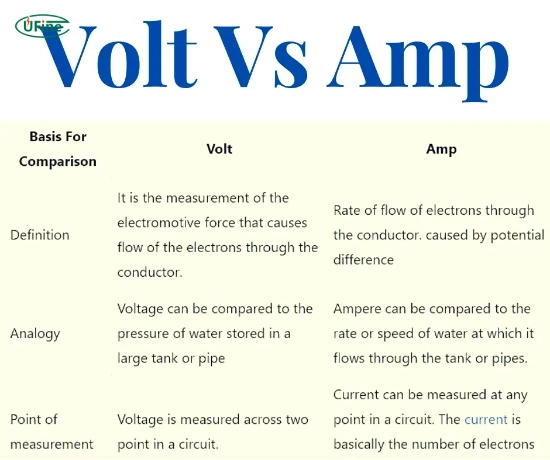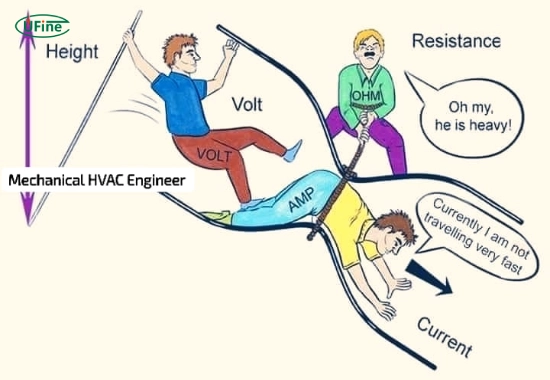
When understanding electricity, grasping the difference between volts and amps is essential. These two terms are fundamental to electrical systems, yet they often need to be clarified for beginners. This guide will explore what volts and amps are, how they relate to each other, and why they matter in everyday life. By the end, you’ll have a clear understanding of these concepts, making navigating the world of electricity easier.
Quick Answer: What’s the Difference Between Volts and Amps?
The main difference between volts and amps is that volts measure electrical pressure, while amps measure the flow of electric current. Voltage pushes the current through a circuit, and amperage is the amount of current flowing.
| Feature | Volts | Amps |
|---|---|---|
| What it measures | Electrical potential (pressure) | Flow of electric charge |
| Unit | Volt (V) | Ampere (A) |
| Analogy | Water pressure in a pipe | Amount of water flowing |
| Formula | V = I × R | I = V ÷ R |
| Use case | Determines how hard electricity is pushed | Determines how much electricity is flowing |
Part 1. What are volts?
Volts, symbolized by V, measure the electrical potential difference between two points in a circuit. Think of volts as the pressure that pushes electric current through a wire. Like water pressure pushes water through pipes, voltage pushes electric charges through conductors.
Key Points About Volts:
- Definition: Volts measure the potential energy available to move electric charges.
- Unit of Measurement: The standard unit for voltage is the volt (V).
- Role in Circuits: Higher voltage means more potential energy, which can push more current through a circuit.
Consider a battery to illustrate this concept. A typical AA battery has a voltage of 1.5 volts, which means it can provide enough electrical pressure to power small devices like remote controls or flashlights.
Part 2. What are amps?
Amps, or amperes, denoted by the symbol A, measure the flow of electric current in a circuit. In simple terms, amps tell you how many electrons are flowing through a conductor at any given moment. This measurement is crucial for determining how much electricity is being used by devices.
Key Points About Amps:
- Definition: Amps measure the rate at which electric charge flows.
- Unit of Measurement: The standard unit for measuring current is the ampere (A).
- Role in Circuits: Higher amperage indicates a greater flow of electricity.
For example, when you plug in an appliance that draws 10 amps at 120 volts, 10 units of electric charge flow every second to power that device.
Part 3. How do volts and amps relate to each other?
Volts and amps are closely related; understanding their relationship is crucial in any electrical system. For a detailed comparison, check out our guide on voltage vs current. Their connection is best explained using Ohm’s Law, which states:
The formula is:
- V = I × R — Voltage equals current multiplied by resistance.
Understanding this relationship helps you control current flow by adjusting either the voltage or resistance in a system. For example:
- If voltage stays the same but resistance increases, the current (amps) decreases.
- If resistance drops, the current increases—this is often seen in damaged wires or short circuits.
This relationship is crucial when designing battery systems, electrical circuits, or home wiring to ensure safe and efficient power flow.
Part 4. Understanding watts
To further clarify how volts and amps work together, we must introduce watts (W), which measure electrical power. Power can be calculated using the formula:
- P=V×I
Where:
- P = power (watts)
- V = voltage (volts)
- I = Currencurrent)
This formula illustrates that power increases with higher voltage or higher current. For instance, if you have a device that operates at 120 volts and uses 2 amps, you can calculate its power consumption as follows:
P=120×2=240 watts
This means that your device consumes 240 watts of power while operating
How Volts and Amps Work Together in Real Devices?
Think of voltage and amperage as a team. Voltage provides the push, and amperage is the result of that push. The more volts you have, the more potential energy is available. The more amps you have, the more electrons flow through the circuit. The power you get—measured in watts—combines both.
Here’s a real-life example:
- A smartphone charger typically outputs 5 volts and 2 amps.
- That gives you 10 watts of power (P = V × I).
This synergy is why understanding both units is essential for choosing the right charger, battery, or circuit design.
Part 5. Practical applications of volts and amps
Understanding volts and amps is crucial for various applications in daily life:
- Home Appliances: Different appliances require specific voltages and amperages to function correctly. For example, most household outlets provide 120 volts, suitable for small appliances like lamps and televisions. However, larger appliances such as dryers or ovens may require 240 volts.
- Electrical Wiring: When installing or upgrading wiring in your home, it’s vital to consider both voltage and amperage ratings. Using wires that can handle the correct amperage ensures safety and prevents overheating.
- Battery Systems: In battery-powered devices, knowing the voltage and amp-hour rating helps determine how long a device will run before recharging. For example, a battery rated at 12 volts with a capacity of 10 amp-hours can provide power for one hour at a rate of 10 amps.
Part 6. Common misconceptions about volts and amps
Many people confuse volts with amps due to their close relationship in electrical systems. Here are some common misconceptions:
Misconception 1: Higher voltage always means more power.
Reality: Power depends on both voltage and current; high voltage with low current delivers less power than low voltage with high current.
Misconception 2: Amps are more dangerous than volts.
Reality: Both can be dangerous, depending on the situation. High voltage can cause severe shocks even at low current levels.
Part 7. Safety considerations when working with electricity
When dealing with electricity, safety should always be your top priority:
- Always turn off the power before working on electrical circuits.
- Use insulated tools to prevent accidental shocks.
- Ensure that your electrical system meets local codes regarding amperage ratings for wiring and breakers.
Understanding these safety measures can help prevent accidents and ensure your electrical systems function correctly.
Part 8. FAQs
-
What’s the Real Difference Between Volts and Amps?
Volts measure the pressure pushing electrical current, while amps measure the current flow. Both are critical: voltage determines how fast current can move, and amperage shows how much electricity flows. Power devices require the right balance of both. -
Can I Use a Higher Voltage Appliance on a Lower Voltage Circuit?
No, using a higher voltage appliance on a lower voltage circuit can cause malfunction or damage to the appliance due to an insufficient power supply. -
How Do I Calculate Watts from Volts and Amps?
To calculate watts from volts and amps, use the formula P=V×I. For example, if you have 120 volts and 2 amps, P=120×2=240 watts. -
Why Is It Important to Know My Circuit’s Amp Rating?
Knowing your circuit’s amp rating helps prevent overloads that could lead to overheating or fires. It also ensures that your wiring can safely handle the current generated by connected devices. -
How Do I Measure Voltage and Current?
You can measure voltage using a multimeter set to the voltage setting. To measure current, you’ll connect the multimeter in series with the circuit under test.
Related Tags:
More Articles

Server Rack Battery vs UPS Battery: What’s the Difference
Discover the difference between server rack and UPS batteries. Compare design, chemistry, performance, and maintenance to select the best data center backup.
How to Choose the Right Server Rack Battery for Your Data Center?
Find out how to choose the right server rack battery for your data center. Consider capacity, runtime, safety, and compatibility for reliable backup power.
What Is a Server Rack Battery? A Complete Guide for Data Centers and IT
Discover what a server rack battery is, how it works, and why it’s essential for reliable data center and IT power backup. Learn key features and benefits.
Understanding the Difference Between AA and AAA Batteries
Wondering about the difference between AA and AAA batteries? Learn the key differences, similarities, and when to use each in this detailed guide.
3S LiPo Batteries Explained – How to Pick the Best 3S Battery
This guide includes 3S voltage charts, capacity options, life, safety rules, and top recommended batteries — so you can choose the best 3S LiPo battery.





